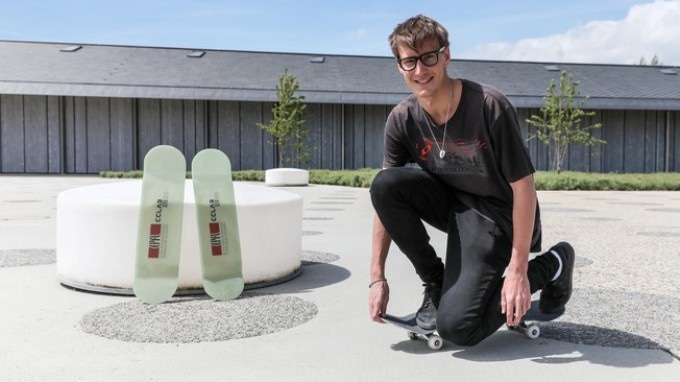May 23 2018
EPFL’s civil engineering student Damien Sommer dimensioned and ultimately developed a unique fiberglass skateboard for his Master’s project. When digital techniques are applied to the design process, a product is obtained that is more solid than a conventional skateboard. The skateboard will be available for test rides on 24 May at EPFL’s Vivapoly.
 Damien Sommer validated his design by making prototypes. (Image credit: © Alain Herzog / 2018 EPFL)
Damien Sommer validated his design by making prototypes. (Image credit: © Alain Herzog / 2018 EPFL)
It makes sense to make a skateboard from fiberglass rather than wood because the former offers a number of benefits. For example, fiberglass lends itself to novel skateboard designs and it is also waterproof and relatively more resilient than the materials utilized in commercially available boards.
This is the main idea behind the Master’s project conceived by Jean-François Molinari, a full professor and head of the Computational Solid Mechanics Laboratory (LSMS), part of Civil Engineering Institute of EPFL; and Anastasios Vassilopoulos, a senior researcher at EPFL’s Composite Construction Laboratory (CCLab), which is a hybrid civil engineering/architecture laboratory. On Thursday, 24 May, people attending the Vivapoly event can try out the fiberglass skateboard displayed at the Travel GC stand.
We wanted to come up with a project that was a little fancier than usual. So we asked a student not only to dimension a structural component, but also to make it himself and test it, to observe its strengths and weaknesses. We thought designing a skateboard would be a good idea as it was feasible to manufacture and validate the functionality of our product. In any case, the dimensioning method is similar for composite materials whether you’re making a skateboard, a bridge or an aircraft – apart from the proportions and the specifications of course.
Anastasios Vassilopoulos
For the professor, two benefits are provided by this method: it allowed the student to exceed the analytical level and provided him the satisfaction of developing a finished product.
The challenge was taken up by the civil engineering student Damien Sommer, who is also an avid skateboarder and elite volleyball player. Standing at six feet tall, Sommer had to create a board that would not flex excessively under his weight. Therefore, for the initial phase of his project, he needed to determine how the fiberglass would behave under different loads on the basis of the traditional theory of laminated composite materials. To achieve this, he employed quality standards considering a skateboard’s flexural rigidity derived by Anthony Bert, a French engineer whom he contacted.
Based on that, Sommer had to adapt the skateboards’ flexural rigidity to the normal values required for the traditional wooden skateboards. To validate his design, Sommer made prototypes and carried out a number of experimental investigations, utilizing instruments from the Laboratory of Applied Mechanics and Reliability Analysis, which is part of the School of Engineering (STI), and the Structural Engineering Group (GIS/ENAC).
Longer life
Nowadays, the basic wooden structure is strengthened by using composite materials such as carbon or glass fibers reinforced polymers in specific parts of a skateboard. But, many bicycles, skis, and snowboards are fully made of fiber reinforced polymer materials, providing them exceptional mechanical properties. The reason for not making composite skateboards is yet to be available.
Maybe skateboard manufacturers just like to stick with what they know. Developing a 100%-fiberglass skateboard requires a little more technical knowledge. Nevertheless, materials and manufacturing are not much more expensive, and a fiberglass skateboard will have a much longer life than a wooden board that absorbs moisture and always ends up breaking.
Damien Sommer
Sommer is well aware of this issue because has an entire collection of broken pieces of skateboards in his attic, which he develops into frames for sunglasses. When it comes to riding the fiberglass skateboards, skaters will be initially surprised, says Sommer: “For the first few minutes, you really have to adjust your technique, because when you land a trick, you feel the board flexing under your feet. This is when traditional wooden skateboards normally break.”
Future Developments
It was during a semester project in winter 2017 that Sommer began to work on this concept and primarily focused on a fiberglass-reinforced wooden skateboard. This was followed by his Master’s project. Sommer and the two professors who managed his work claim that the fiberglass board can be made even more rigid, which would make it possible to perform additional tricks. In addition, the time needed to develop the skateboard, its cost, and its thickness could also be lowered.
The beauty of composite materials like fiberglass reinforced polymers is that they offer much more design possibilities than conventional materials. For example, we can decide how rigid and thick we want the board to be by adjusting the fiber architecture of the material, and therefore make more versatile skateboards.
Anastasios Vassilopoulos
Consequently, the search for the perfect skateboard is going on this spring at EPFL: a novel semester project is being developed, and for interested EPFL students an innovative Master’s project focusing on design and improving the production process of the skateboard is being provided.